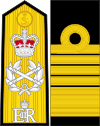Admiral of the fleet
An admiral of the fleet or fleet admiral (sometimes also known as admiral of the navy or grand admiral) is a military naval officer of the highest rank. In many nations the rank is reserved for wartime or ceremonial appointments. It is usually a rank above admiral (which is now usually the highest rank in peacetime for officers in active service), and is often held by the most senior admiral of an entire naval service.
| Naval officer ranks |
|---|
| Flag officers |
| Senior officers |
| Junior officers |
| Military organization | ||||||||||||||||||||||||||||||||||||
|---|---|---|---|---|---|---|---|---|---|---|---|---|---|---|---|---|---|---|---|---|---|---|---|---|---|---|---|---|---|---|---|---|---|---|---|---|
 | ||||||||||||||||||||||||||||||||||||
|
||||||||||||||||||||||||||||||||||||
It is also a generic term for a senior admiral in command of a large group of ships, comprising a fleet or, in some cases, a group of fleets. If actually a rank, its name can vary depending on the country. In addition to "fleet admiral" and "admiral of the fleet", such rank names include "admiral of the navy" and "grand admiral".[Note 1]
It ranks above vice admiral, rear admiral and usually full admiral, and is usually given to a senior admiral commanding multiple fleets as opposed to just one fleet. It is often classified in NATO nations as a five-star rank.
Admiral of the fleet is equivalent to an army field marshal. It is also equivalent to a marshal of the air force which in many countries has a similar rank insignia to admiral of the fleet.
Etymology
The title admiral of the fleet can trace its origins to the Middle Ages, where the title was typically granted to a nobleman who was appointed by a monarch to raise and command a navy for a specific campaign.
Usage in specific countries
The following articles contain specific information on the rank as it pertains to individual countries:
- Admiral of the fleet (Australia)
- Admiral of the Fleet (Bangladesh)
- Admiral of the Fleet (Ethiopia)
- Admiral flote (Croatia)
- Großadmiral (Germany and Austria-Hungary)
- Flottenadmiral (East Germany)
- Amiral de France or amiral de la flotte (France)[Note 2]
- Archinavarchos (Greece)
- Admiral of the fleet (India)
- Ammiraglio (Italy)
- Gensui-kaigun-taishō (Imperial Japan)
- Wonsu (South Korea)
- Laksamana armada (Malaysia)
- Admiral of the Fleet (Nigeria)
- Admiraal (Netherlands)
- Admiral of the fleet (New Zealand)
- Admiral of the Fleet (Pakistan)
- Almirante da armada (Portugal)
- Admiral of the fleet (Russia)
- Admiral of the fleet (USSR)
- Admiral of the Fleet of the Soviet Union
- Capitán general de la real armada española (Spain)
- Chom phon ruea (Thailand)
- Büyük Amiral (Turkey)
- Admiral flote (Socialist Federal Republic of Yugoslavia)
- Admiral of the fleet (United Kingdom)
- Fleet admiral (United States)
- Admiral of the Navy (United States) (1903-1917)
- Mushir (Middle East)
- Admiral of the Fleet (Sri Lanka)
Ambiguity exists when translating the French amiral into English (into admiral of the fleet or admiral). A French title of amiral de la flotte, outranking a full admiral was invented in 1939 for Darlan, who was the only person in French history to hold that title.
Before the fall of the monarchy in 1952, the Egyptian Navy had the equivalent rank of sayed elbehar elazam.
In the Turkish Navy, the corresponding rank büyük amiral, literally meaning "grand admiral", can only be bestowed by the National Assembly, and only given to an admiral who leads the navy successfully in and out of a war, criteria tougher than those for equivalent ranks. No one has ever been bestowed this rank yet in the republican era. During the period of the Ottoman Empire, commanders of the navy carried the rank of kapudan-i derya as equivalent.
Poland
In Poland, the rank is the second highest and is a 3--star rank. The stars are not used; however, except in the very admiral's flag.
Admiral insignia by country
The rank insignia for an admiral often involves four stars or similar devices and/or 3 stripes over a broad stripe, but as one can see below, there are many cases where the insignia do not involve four stars or similar devices.
Gallery

 Laksamana Armada
Laksamana Armada
Royal Brunei Navy Admiral flote
Admiral flote
Croatian Navy Amiral de France
Amiral de France
French Navy Admiral of the fleet
Admiral of the fleet
Indian Navy (Shoulder Board)_OF-10.svg.png) Admiral of the fleet
Admiral of the fleet
Indian Navy (Sleeve Insignia) Laksamana Besar
Laksamana Besar
Indonesian Navy Ammiraglio
Ammiraglio
Italian Navy Ammiraglio
Ammiraglio
Italian Navy Wonsu (원수)
Wonsu (원수)
South Korean Navy Laksamana Armada
Laksamana Armada
Royal Malaysian Navy Almirante Secretario de Marina
Almirante Secretario de Marina
Mexican Navy Admiral of the fleet
Admiral of the fleet
Nigerian Navy.svg.png) Admiral of the fleet
Admiral of the fleet
Royal Navy of Oman Admiral of the fleet
Admiral of the fleet
Pakistan Navy Admirał
Admirał
Polish Navy Almirante da Armada
Almirante da Armada
Portuguese Navy Адмирал флота
Адмирал флота
Russian Navy Адмирал флота
Адмирал флота
Russian Navy (sleeve) Capitán general de la Armada
Capitán general de la Armada
Armada Española.svg.png) จอมพลเรือ
จอมพลเรือ
Royal Thai Navy จอมพลเรือ
จอมพลเรือ
Royal Thai Navy (sleeve) Büyükamiral
Büyükamiral
Turkish Navy
 Fleet Admiral
Fleet Admiral
U.S. Navy
Other countries
The rank also exists or has existed (on paper at least) in Bangladesh, India, Indonesia, Nigeria, Oman and Pakistan, although not all of these countries have actually bestowed the rank on an individual.
Notes
- In some navies, however, such as the German Kriegsmarine during World War II, "admiral of the navy" has been considered a higher rank than "admiral of the fleet" or its equivalent.
- Amiral de France is not a rank but a dignity. The last amiral de France was François Thomas Tréhouart in 1869. This dignity remains fully valid today - Article 19 of Law No. 2005-270 of 24 March 2005 on the general status of the military, "the title of Marshal of France and that of Admiral of France, is a dignity in the state". It is noteworthy that the French title of amiral de la flotte was also used in place of amiral de France, and was exceptionally established in 1939 for François Darlan, who is the only person in the history of France to have held this literal and accurate title. It was intended to prevent Vice-Admiral Darlan (who held the highest rank in the French navy) being junior in rank to his allied counterparts who held the rank of admiral of the fleet
References
- Francis E. McMurtrie and Raymond V.B. Blackman (editors), Jane's Fighting Ships 1949-50. New York: The McGraw-Hill Book Company, Inc., 1949.